Introduction
Many people consider vegetable production to be difficult in the desert. Production of vegetables is possible by selecting suitable crops and using effective growing techniques. Crop selection should use crops suited to the climate and season. This paper outlines what vegetable crops have been successfully grown in warm (3,000- to 4,000-foot elevation) to cold (4,000- to 6,000-foot) desert areas in southern Nevada.
Choose Crops for the Season and Climate
It is important to choose the crop that suits your climate. If you live in elevations over 5,000 feet, then select crops with less than 70 days to maturity. At lower elevations select crops that are adapted to hot summer days. Heat-loving plants perform best for summer due to their tolerance of high temperature (daytime temperatures over 80 degrees F and nighttime temperatures above 55 degrees F). Winter production requires crops with tolerance. Crops can be selected that can tolerate freezing temperatures. The cool spring and fall seasons in the desert are extremely variable in deserts. For the spring and fall, cool season crops should be adapted to wide temperature extremes and have a short production season. Select crops and varieties that are slow to bolt (growth of a spindly seed head in response to hotter temperatures) so that they will maintain quality during warm temperatures days during the season change. Many seed companies will indicate the crop’s length of season to maturity and if it has greater tolerance to a wide range of temperatures.
Varieties that have the broadest optimum temperature range or are labeled as performing well in a wide range of climates often perform well in desert regions as long as they function in low humidity.
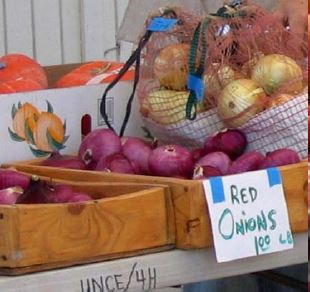
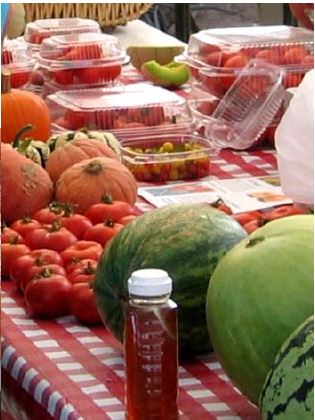
Heat-Tolerant Crops
Heat-loving plants are best suited for summer production in desert climates. The plant families that fit into the heat-loving category are nightshade or Solanaceae (tomatoes, peppers, eggplant) and squash or Cucurbitaceae (cucumbers, melons, summer and winter squash). Corn and beans also perform best in hot climates. For herbs, basil thrives in the heat, even in the hottest desert summers. Varieties that develop produce quickly may perform better than crops with more days to maturity, especially in higher, desert locations. Select varieties that perform better in wide day-to-night temperature swings because they will continue mature during variable temperatures.
Tomato varieties should be selected for end-use desires: small, tasty varieties for salads; large slicers for sandwiches; or meaty good cookers for sauces. In tomatoes, the yield and quality varied depending on how the tomatoes adapted to the variable temperatures. Tomato varieties such as Early Girl, Better Boy and some cherry types performed more consistently. Tomatoes have been shown to perform better when provided a protective cover of shade cloth. Field trials had New Girl tomatoes yield 78 to 84 percent higher under shade cloth covered hoop houses than the same tomatoes in the field without cover (Gatzke, 2012). Hoop houses with shade cloth cover made a great difference in tomato production by reducing the beet curly top virus disease rates. New Girl and Early Girl varieties were used because they have shown consistent performance in the desert but many varieties can perform well. Heirlooms can be grown for their exceptional taste, unique appearances and premium prices. Heirloom tomatoes required more care in production and handling because many are prone to damage and disease. With lower yields and greater losses it is important to calculate heirloom returns since their lower saleable volume and greater cost of handling could exceed the premiums obtained in higher prices. More information on tomato variety selection and production in hoop houses is available at High Tunnel Tomato Production (Hunter et.al. 2010).
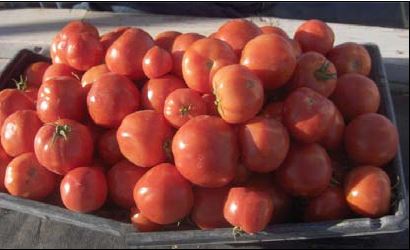
Peppers varieties should be selected for desired uses of target consumers, which vary greatly. Jalapeños, ancho and sweet banana peppers provided high quality and good yields. Peppers vary in whether yield and quality improve under protection from shade cloth. Jalapenos yielded better in full sun. Sweet banana peppers have been shown to be heavier and higher quality when grown under shade cloth. In desert regions at around 4,000 feet of elevation, sweet bell peppers often fail to develop a thick fleshy wall, especially upon ripening, and their quality can be poorer than store-bought bells. Specialty peppers (hot or sweet) of different varieties should be tested in your region to determine which ones grow into quality products. The successful types should also be tested by the consumers as their tastes can vary greatly on what they will buy.
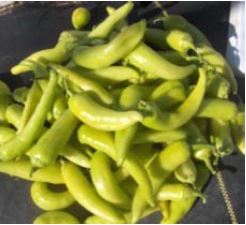
Eggplants grow well in the open desert. Studies showed a disadvantage to using shade cloth over eggplant (Gatzke, 2012). It is best to pick varieties that remain fleshy on the inside with few seeds. Avoid varieties that will quickly set a large amount of tough seeds on the inside (a slender green and small stripped plump variety). Select the types that fit your market and maximize yield. Some chefs prefer small, slender, fleshy and flavorful Japanese types (variety - Magnum).
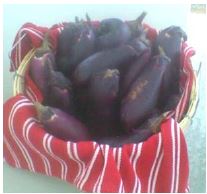
All types of summer squash tested grew well in the desert. Summer squash were chosen for their uniqueness for the markets and the ability to harvest an abundance of both quality fruit and blossoms for use. Chefs preferred fruit with amazing color, nice texture, and consistency throughout the fruit. Consumers favor golden zucchini (variety – Golden Dawn III) over yellow crookneck due to a firmer texture and more flavor after cooking. Squash blossoms are a great add on crop that is highly specialized and sought out by chefs and food lovers. It was estimated that a third of the male blossoms could be harvested without impacting pollination and full female blossoms with a tiny squash attached are premium priced. Golden zucchini can yield 4.5 pounds of fruit per square foot in addition to yields of one blossom per square foot per week for the 15-week harvest period. Squash bug infestations are the major production problem that needs to be controlled for all summer squash, regardless of the variety. Control with several pesticide applications can be achieved if started early. Organic control systems are not consistently effective. Vacuuming them off the plants, covering with row cover, and diatomaceous earth has been recommended as having some benefit in controlling them.
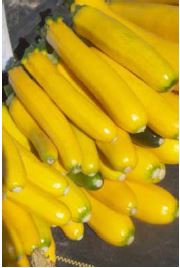
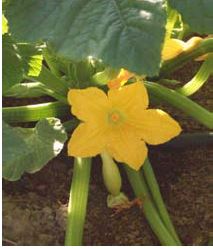
Of the winter squashes, butternut and pumpkin consistently produce a crop whereas some others grew slowly and would lose quality and yield due to immaturity with fall frost. Melons, cantaloupes and some watermelons performed well, whereas Crenshaw, casaba and honeydews were less reliable. Often the shorter season types and varieties produced higher yields and better quality product reliably such as Ambrosia cantaloupe.
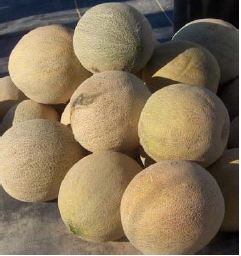
Cucumbers can be inconsistent in quality because of gaps forming inside by the seeds and different viruses invading crops. Variety selection for disease resistance and consistent watering can help to address these problems.
Cold-Tolerant Crops
Cold-tolerant crops grow even when temperatures fall well below freezing. Plant protection is required with a plastic covered hoop house or plastic covered low tunnels. The growth rates of the crops are slowed with growth only occurring on days with temperatures warming above 50 degrees F. The labor required during the winter growing season is low because of less watering and few to no pest problems and weeds. In real cold periods, extra protection, such as a low tunnel of plastic or frost cloth within the high tunnel or hoop house, provides protection and increased growth rates. Success or failure of a crop in a desert can differ within crop types and even between crop varieties. Growth or survival will differ greatly not only between crops but between varieties of the same crop (Gatzke, 2012). The crops that perform well in the field studies are cold tolerant lettuces: Flashy Trout Back, Winter Density green romaine, Rouge d’Hiver red romaine and Red Salad Bowl red oak leaf. These lettuces grow at nearly the same times and growth rates and can be seeded together in a blend to create a salad mix. These winter greens can be harvested in the baby sizes because they grow slowly and remain tender. Baby greens can yield 0.66 pounds per square foot from several cuttings with just the hoop house covered in plastic at 3,200-foot elevation and with frost cloth inside the hoop house at 4,700-foot elevation. Studies in the cold region of Utah showed greater plant growth from using a frost cloth inside of a low tunnel covered with plastic and that low tunnel used inside of the hoop house (Hunter et.al., 2010). On sunny days the low tunnel may need to be opened so it does not get too warm. A study of different winter lettuce varieties can be found at Washington State Extension, Winter Lettuce.
Arugula, spinach, swiss chard, mustard, crinkle cress and kale grow but somewhat slower than the winter lettuce throughout the winter. Example yields per square foot were: 0.8 pounds for Tyee spinach, 0.6 pounds for Ruby Streaks mustard, and 0.97 pounds for Russian Red Ragged Jack kale. Swiss chard, spinach and kale can produce through several cuttings and continue growing into the warmer weather of spring. Toscano kale did not perform in the cold planting times of the early winter but has grown well in the spring. Mustard grows more rapidly in the cold than the other crops but decreases production with the spring warming.
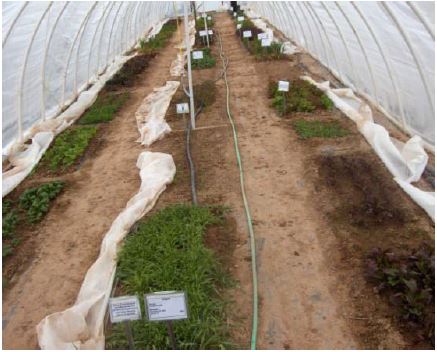
Root crops can grow well during the winter. Parsnips grown through the summer and kept in the ground in the cold provides a flavorful winter product. Garlic and carrots can be seeded in the fall for harvest the next spring. Beets have grown through the winter in the warmer desert climate (3,200-foot elevation) to finish in the spring. In the colder regions, beets can freeze or not form fleshy roots at 4,700 foot elevation in the hoop house. Although nice crops of carrots and beets can be produced after a fall planting, they were not ready for harvest until nearly the same time in late spring or early summer as a very early seeded spring crop. Garlic will grow during the winter in the hoop house to create an earlier crop in the summer. Garlic variety Sam Loiacono produces more than Red Toch. Starting onions from young plant starts early in spring has been more successful than seeding the onions in the fall due to difficulties with seed establishment and cold tolerance in the fall seeded onions. Ground rodents love to find the winter root crops for winter feed so eliminating rodents in the growing area and beyond is important.
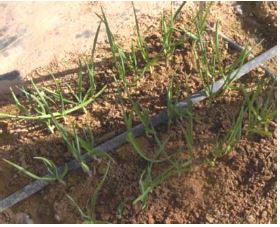
Spring or Fall Crops
Cool weather crops are the most suited for spring and fall production. These crops thrive in cool weather but do not handle the frost like the cold tolerant crops used for winter production. Common normal cool season crops such as those in the Brassica family (cabbage, broccoli, cauliflower, radishes, etc.), peas, beets, greens, carrots, onion family (chives, onions, leeks, etc.) grow well in the average temperatures found in deserts. To get a successful crop, it is essential to protect the plants from the extremely variable day to day temperatures and day to night differences. Changing weather fronts and temperatures in desert regions are some of the most extreme found on the globe. Temperatures of 32 degrees Fahrenheit days can turn into a warm spell reaching 90 degrees Fahrenheit and the opposite can happen in a day. Sometimes the fall or spring crop is lost if changing weather fronts with extreme temperatures continues for too much of the season and the productive plant growing days are shortened below the needed days to maturity. It is important to use systems to control the environment for the plants to achieve enough days in the required temperature range to grow quality produce before extreme heat or cold damages the plants.
Fall and spring crops become possible by using temperature protection mechanisms such as hoop houses, low tunnels and frost blankets. for winter production (Gatzke et.al., 2009; Bachmann, 2008). Spring and fall production require more labor to add extra cover to hold heat from the late afternoon into the nights and then opening the covers during the morning to provide ventilation and prevent overheating during the day. Weather should be monitored closely for warm or cold fronts to determine when to provide plant protection for the extreme changes. In nature, plants adapt to different climates with gradual change but not rapid change. The same variety of plant can handle cool (or hot) temperatures very well if they are gradually moved to that temperature. But plants are shocked greatly, if the same temperature change occurs within hours, even to the point of dying.
The plants that have the greatest potential for success are those ready for harvest in a very short time such as radishes (30 to 40 days maturity). Many of the cool season crops do have shorter days to maturity (50 to 60 days to maturity) that can achieve more harvests. Varieties should also be selected for the greatest tolerance to temperature changes. Growing different crops and varieties in your garden over several years is the best system to determine the successful crops.

Crop Performance
Crops should be selected to provide consistently good yields and high quality. The yields achieved in desert production are usually lower due to extreme growing conditions. Quality can be very good due to less disease and good flavor. Experienced producers commonly adjust estimated yields like those published in Johnnie’s seed catalogue by reducing them by one half. These figures are considered a good estimate for top quality harvest that can be harvested and sold at the farmers’ market or chef market. Any higher yields of saleable product on good years would be a bonus. Field data can show losses of 5 to 40 percent produce being culled for insufficient quality for sale to the premium markets.
Crops can be selected to achieve the broadest possible range of harvest dates to provide produce all year long rather than huge crops a few times. A steady stream of harvests can be achieved by utilizing a variety of crops or different varieties of the same crop that differ in the number of days to maturity. In many areas, growers recommend planting seeds every week or two to spread out the harvest. The local desert research shows harvest dates are poorly related to seeding date and the harvesting date of many crops were more dependent on temperature. The crops matured faster if they did not spend too much time in too cold or too hot of temperatures compared to that plant’s optimal range. In the desert, spreading the harvest is best achieved through varying the crops and varieties.
Market Considerations
Any crops considered for desert production should also be those that can be sold in a premium market or loved in your kitchen. To get premium prices, avoid common commercial products. Aim for products that cannot be obtained at the local grocery store, either because of variety, availability, quality or any combination thereof. Crops selected to meet the desires of high-end urban chefs and local farmers markets consist of specialty vegetables such as baby or miniature sizes, specialty greens, ethnic foods and heirlooms (Bachmann, 2002). High-end chefs desire fresh, unique, flavorful products that are supplied in reliable qualities (Cowee et.al, 2009).
Farmers market customers want familiar, pretty-looking produce like in the supermarket and something they know how to cook (traditional, cultural or products on cooking shows).
Conclusions
High quality vegetables can grow well in desert regions. Select crops and varieties that handle desert extremes in climate and that are suited to the season. Use protection such as shade cloth, hoop houses, low tunnels and frost cloths to optimize the environment around the crop. Information found in publications from University publications, seed catalogues and from local successful growers can help narrow the choice of crops. Then, grow the most likely crops for several years to identify your favorite successful crops.
REFERENCES
Bachmann, J. 2002. Specialty Vegetables. Appropriate Technology Transfer for Rural Areas (ATTRA). National Sustainable Agriculture Information Service. ASK A SUSTAINABLE AG EXPERT
Bachmann, J. (revised 2008). Season Extension Techniques for Market Gardens. ATTRA. National Sustainable Agriculture Information Service. Season Extension Techniques for Market Gardens
Bishop, C., H. Gatzke, and K.R. Curtis. 2010. Small Farm Hoop House Production of Vegetables in Desert Climates Costs & Returns, 2010. UNCE Special Publication-10-11.
Cowee, M.W., K.R. Curtis, R. Morris and H. Gatzke. 2009. Buying Local: Perceptions of High-End Chefs in Nevada. UNCE Fact Sheet-09-41.
Gatzke, H., 2012. Hoop house Production in the Desert; Solanaceae and Cucurbitaceae Crops. UNCE Special Publication-12-??.
Gatzke, H., D. B. Nelson and G. McCuin. 2009. Plant Season Extension in the Desert. UNCE Fact Sheet-09-39.
Hunter, B., D. Drost, and B. Black. 2010. High Tunnel Tomato Production. Utah State University Cooperative Extension. 2101-03pr. High Tunnel Tomato Production
Hunter, B., D. Drost, and B. Black. 2010. High Tunnel Lettuce in Utah. Utah State University Cooperative Extension. 2101-04pr. High Tunnel Lettuce in Utah
WSU. 2010.Winter Lettuce. Washington State Extension. Winter Lettuce
Thank you to NIFA for funding this work.
Gatzke, H.
2012,
Selecting Vegetable Crops for Small-Scale Desert Production,
University of Nevada Cooperative Extension


